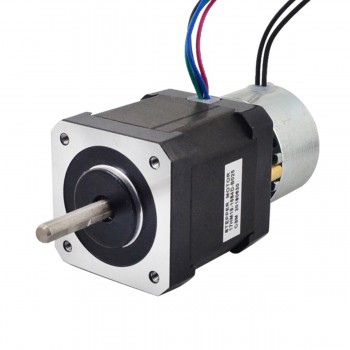1.Introduction
Brake stepper motor is a common type of motor, widely used in various mechanical equipment and industrial automation systems. It has the characteristics of precise control, high-efficiency conversion and fast response, and is widely used in automobiles, robots, printing equipment, CNC machine tools and other fields.
2.Working principle
First of all, the working principle of brake stepper motor is designed based on the principle of stepper motor. Stepper motor achieves precise angular displacement through pulse control of current, and brake stepper motor adds electronic brake system on the basis of traditional stepper motor. This brake system detects the movement state of the motor through sensors. When it needs to stop, it will send a brake signal through the electronic control system to stop the motor immediately. This brake system has the characteristics of fast response and can achieve braking action within milliseconds to ensure the safety and stable operation of the equipment.
3.Main features
The main features of brake stepper motor include precise positioning, high-speed movement, low noise and controllable movement.
1.Precise positioning: Brake stepper motor can accurately control the rotation angle and speed, so that it can achieve precise positioning and control in various applications. ?This precision makes the brake stepper motor perform well in situations where high-precision positioning is required, such as printing equipment, textile machinery, medical equipment, etc.
2.High-speed movement: The brake stepper motor has the characteristics of fast response and high-speed movement, and is suitable for situations where frequent rotation and switching of angles are required. ?This feature enables the brake stepper motor to complete work tasks efficiently and improve work efficiency. ?
3.Low noise: Compared with other types of motors, the brake stepper motor has lower noise and is suitable for application scenarios with high noise requirements. ?This low noise feature helps to improve the quality of the working environment and reduce interference to operators.
4.Controllable movement: The brake stepper motor can achieve precise motion control by controlling the input and switching of current, making it more flexible and controllable. ?This controllability enables the brake stepper motor to adapt to various complex motion control needs. ?
In addition, the brake stepper motor also has the advantages of small size, short reaction time, and low power consumption. These characteristics further enhance its application potential in compact spaces and provide stable braking torque to ensure the stable operation of the equipment.
In addition to the above basic characteristics, the brake stepper motor can also derive some other related contents. For example, the control system of the brake stepper motor can be combined with other control devices to achieve more complex motion control functions. It can be used in conjunction with encoders, sensors, etc. to realize a closed-loop control system and improve the positioning accuracy and stability of the system. In addition, the brake stepper motor can also be connected to the automatic control system to realize automated production and collaborative work between equipment and systems. This feature makes it play an increasingly important role in intelligent manufacturing in the era of Industry 4.0.
4.Summary
In summary, the brake stepper motor is a powerful and widely used type of motor. It achieves fast response and accurate stopping action through the brake system, and has the advantages of precise control, high-efficiency conversion, and start-stop stability. It is widely used in various mechanical equipment and industrial automation systems. With the continuous development and innovation of technology, brake stepper motors will surely play a more important role in the future industrial field and provide strong power support for modern manufacturing and automated production.








